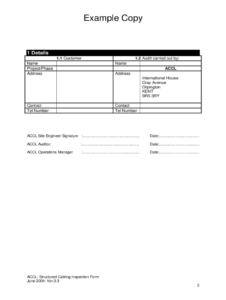Working with fiber optics is complex. From installations to troubleshooting, keeping track of every connection, splice, and test result is crucial. Without clear and organized documentation, projects can quickly descend into chaos, leading to costly errors and delays. That’s where a fiber optic documentation template comes in handy. Think of it as your project’s central nervous system, providing a clear pathway to understanding and managing your fiber optic infrastructure.
A good fiber optic documentation template isn’t just about filling out forms; it’s about creating a living document that evolves with your network. It should be easily accessible, understandable by different team members, and consistently updated to reflect any changes. This ensures everyone is on the same page, reducing confusion and improving efficiency across the board.
So, what makes a fiber optic documentation template effective? What key information should it capture? And how can you choose the right template for your specific needs? Let’s dive in and explore the essentials of fiber optic documentation and how a well-structured template can be your best friend in the world of fiber optics.
Why Accurate Fiber Optic Documentation is Non-Negotiable
Imagine trying to find a single needle in a massive haystack. That’s what troubleshooting a poorly documented fiber optic network can feel like. Accurate documentation isn’t just a nice-to-have; it’s a fundamental requirement for efficient network management, maintenance, and future upgrades. Without it, you’re essentially flying blind, relying on guesswork and potentially causing more harm than good. Think about the time and resources wasted when technicians have to spend hours tracing cables and deciphering cryptic labels simply to perform a routine task.
Good documentation plays a critical role in disaster recovery. In the event of a network outage or a major equipment failure, having detailed records of your fiber optic infrastructure allows you to quickly identify the problem area, isolate the issue, and implement a solution. This minimizes downtime and prevents further disruption to your services. Without a readily available and accurate fiber optic documentation template, the recovery process can be significantly delayed, leading to substantial financial losses.
Furthermore, accurate documentation is essential for compliance. Many industries, such as telecommunications, healthcare, and finance, are subject to strict regulations regarding network security and data integrity. Maintaining detailed records of your fiber optic infrastructure helps you demonstrate compliance with these regulations and avoid potential penalties. It also simplifies audits and provides a clear audit trail in case of any investigations.
Consider the long-term benefits as well. As your network grows and evolves, accurate documentation becomes increasingly valuable. It provides a historical record of all changes, upgrades, and modifications, allowing you to plan for future expansions and avoid compatibility issues. It also facilitates knowledge transfer between different teams and ensures that institutional knowledge is preserved even when experienced personnel leave the organization.
Ultimately, the investment in comprehensive fiber optic documentation, often supported by a well designed fiber optic documentation template, pays for itself many times over in terms of reduced downtime, improved efficiency, enhanced security, and long-term cost savings. It’s a cornerstone of responsible network management and a key enabler of business success.
Key Elements of a Comprehensive Fiber Optic Documentation Template
A truly useful fiber optic documentation template needs to cover all the essential aspects of your fiber optic infrastructure. It should be structured in a logical and intuitive way, making it easy to find and update information. While the specific fields may vary depending on the complexity of your network, certain core elements are indispensable.
First and foremost, you need detailed information about each fiber optic cable. This includes the cable type (e.g., single-mode, multi-mode), the number of fibers, the cable length, and the manufacturer. You should also record the physical location of the cable, including the starting and ending points, any intermediate connection points, and the path it follows through the building or underground conduit. Visual aids, such as diagrams or floor plans, can be extremely helpful in this regard.
Next, the template should capture all relevant information about the connectors and splices. This includes the connector type (e.g., LC, SC, ST), the polish type (e.g., UPC, APC), and the insertion loss. For splices, you should record the splice method (e.g., fusion, mechanical) and the splice loss. Detailed information about connectors and splices can help identify potential sources of signal degradation and facilitate troubleshooting.
Testing and measurement data is another critical component of a comprehensive fiber optic documentation template. This includes optical loss test set (OLTS) readings, optical time-domain reflectometer (OTDR) traces, and power meter readings. The template should allow you to record the date of the test, the equipment used, and the test results. This information can be used to track the performance of your fiber optic links over time and identify any potential problems before they cause a network outage.
Finally, the template should include sections for documenting network topology, equipment configurations, and any other relevant information that might be useful for managing and maintaining your fiber optic infrastructure. This could include details about the transceivers used, the wavelengths supported, and any special considerations for specific fiber optic links. By capturing all of this information in a consistent and organized manner, you can create a valuable resource that will help you keep your fiber optic network running smoothly for years to come.
Conclusion
In the end, a well-crafted fiber optic documentation template is an invaluable asset for any organization relying on fiber optic technology. It simplifies network management, reduces downtime, and provides a solid foundation for future growth. It’s about taking control of your fiber optic infrastructure and ensuring that you have the information you need to make informed decisions.
By investing the time and effort to create a comprehensive and user-friendly fiber optic documentation template, you’re not just documenting your network; you’re investing in its future. You’re empowering your team to work more efficiently, troubleshoot problems more effectively, and ultimately deliver a better experience for your customers.



